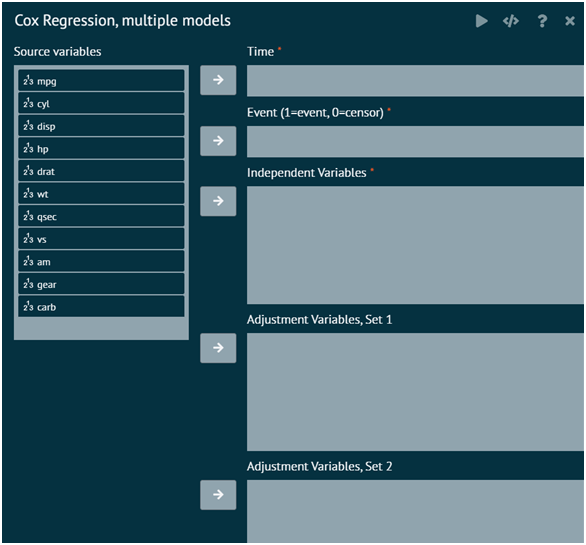Cox Regression, Multiple models
This creates a table containing results from Cox regression models for provided time and event variables. Separate Cox regression models will be fit for each independent variable, optionally adjusted for a set of additional variables. If a strata variable is specified, separate models will be fit for each of the stratification variable values. As an example, if no adjustor or stratification variables are specified, then the table will include all univariate models for the list of independent variables. Various statistics from each model can be output.
To analyse it in BioStat Prime user must follow the steps as given.
- Steps
Load the dataset -> Click on the Model Fitting tab in main menu -> Select Regression -> This leads to analysis techniques, choose Cox Regression, Multiple models -> There will appear a dialog -> It is required to select the independent variables in the dialog, set time and set event -> Finally execute the plot and visualise the output in output window.

Attributes
- Time
Time variable for each Cox regression model. The variable class must be a numeric type.
- Event (1=event, 0=censor)
Event variable for each Cox regression model. A value of 1 indicates the event occurred and 0 indicates the event did not occur. The variable class must be a numeric type.
- Independent Variables
Independent variables to include in the models. The variable classes can be a numeric type, character, factor, or ordered factor.
- Adjustment Variables (Sets 1-5)
Optional variables to be included in a model with the independent variables. The variable classes can be a numeric type, character, factor, or ordered factor. Specifying more than one set of adjustor variables will provide separate models with each set of adjustor variables.
- Strata
Optional stratification variable. Separate models will be fit for the subset defined by each of the stratification variable values. The variable class can be character, numeric, factor, or ordered factor.
- Weights
Optional case-weights to be used in the models. Specifying a weights variable will fit weighted regression models.
- Digits After Decimal Continuous Values
The number of decimal places to show for all continuous values in the table (default=4) P-Values
The number of decimal places to show for all p-values in the table (default=4) Hazard Ratios
The number of decimal places to show for all hazard ratios in the table (default=4)
Options
Parameter Estimates and Hazard Ratios
- Parameter Estimates
Show parameter estimates (coefficients) from each model.
- Standard Errors
Show standard errors of the parameter estimates.
- Confidence Interval Level
Level for the parameter estimate and hazard ratio confidence intervals (default=0.95).
- Parameter Wald Confidence Intervals
Show Wald-based confidence intervals for the parameter estimates.
- Hazard Ratios
Show hazard ratios for each parameter estimate (exp(coefficient)).
- Hazard Ratios Wald Confidence Intervals
Show Wald-based confidence intervals for the hazard ratios.
- Adjustment Variables
Show model output for the adjustment variables.
- Adjustment Names
Show a column delineating model types (unadjusted and different adjustment variable sets). Mostly useful when you don't want to show model output for the adjustor variables.
Sample Size
- Sample Size
Show the sample size used from each model.
- Number Missing, if any
Show the number of observations not used in each model (missing values), only if there are some not used.
- Number Missing, always
Show the number of observations not used in each model (missing values), regardless of whether there are some observations not used.
- Number of Events
Show the number of events from each model.
Fit Statistics
- Concordance
Show the model concordance statistic.
- Concordance Standard Error
Show the standard error of the model concordance statistic.
- R-Squared
Show a pseudo R-squared value from each model (Nagelkerke's R-squared)
- R-Squared Maximum
Show the maximum possible value for the pseudo R-squared value from each model (Nagelkerke's R-squared)
- Akaike Information Criterion (AIC)
Show the model Akaike Information Criterion
- Bayesian Information Criterion (BIC)
Show the model Bayesian Information Criterion
- Log-Likelihood
Show the model log-likelihood value
P-Values
- Parameter Estimates (Wald Test)
Show the p-values from the individual parameter Wald tests
- Likelihood Ratio Tests (not adjustors)
Show the p-values for each independent variable based on a likelihood ratio test. This compares a model with the independent variable to a model without the independent variable, including any adjustor variables in both models.
- Model Score Test
Show the p-value from the overall model score test.
- Model Likelihood Ratio Test
Show the p-value from the overall model likelihood ratio test.
- Model Wald Test
Show the p-value from the overall model Wald test.
Test Statistics
- Parameter z-statistics (Wald Test)
Show the z-statistics from the individual parameter Wald tests.
- Model Score Test
Show the overall model score statistic.
- Model Likelihood Ratio Test
Show the overall model likelihood ratio test statistic.
- Model Wald Test
Show the overall model Wald test statistic.